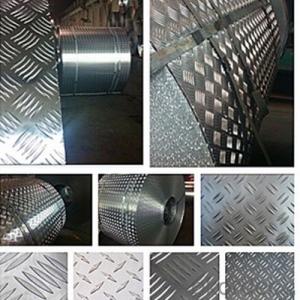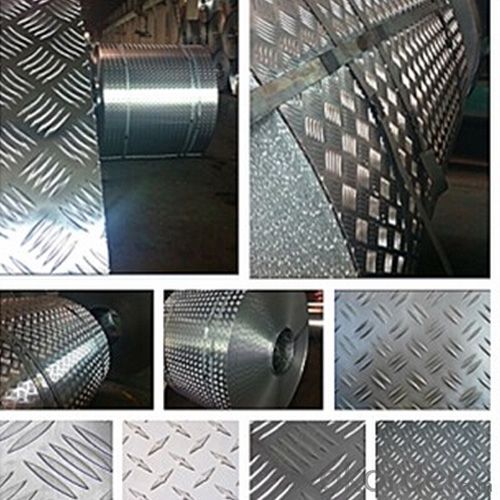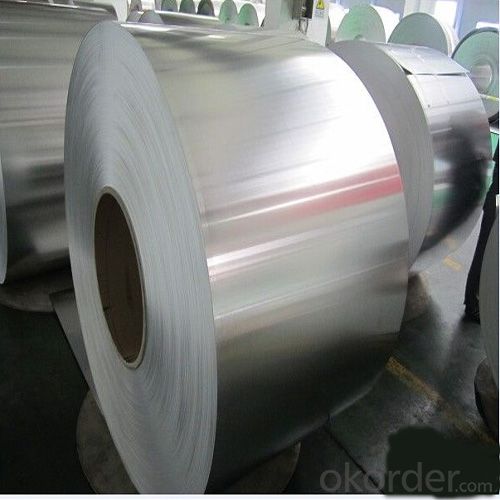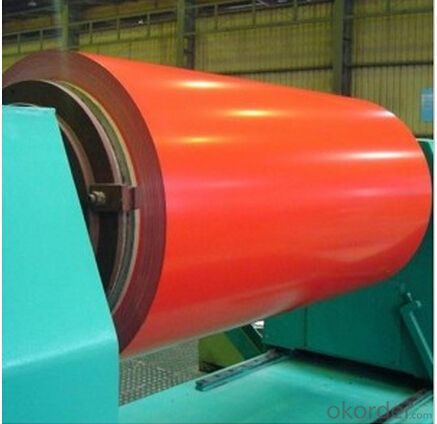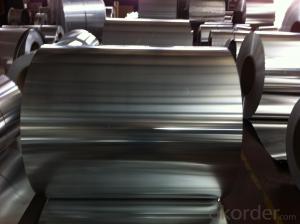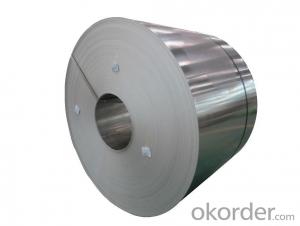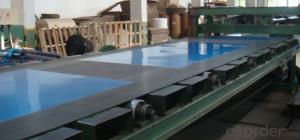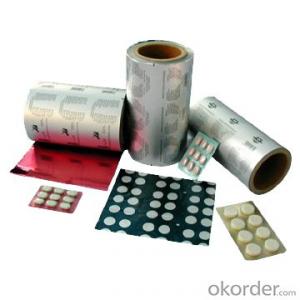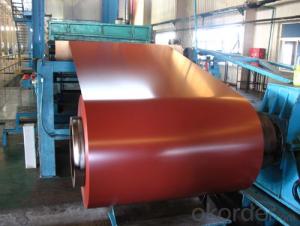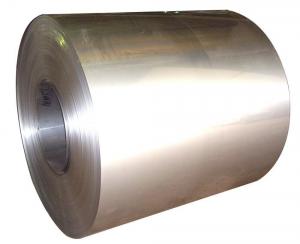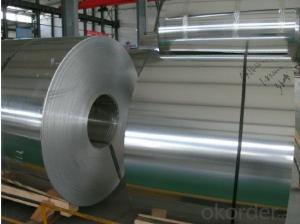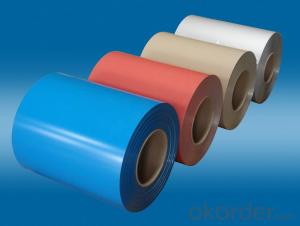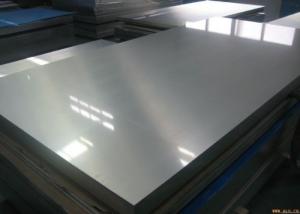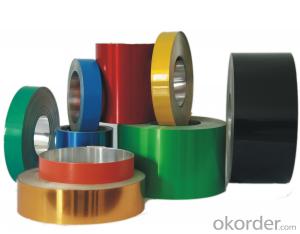Decorative Aluminum Coated Mylar Plastic Sheets for Aluminium Roofing Coils
- Loading Port:
- Shanghai
- Payment Terms:
- TT OR LC
- Min Order Qty:
- 5 m.t.
- Supply Capability:
- 10000 m.t./month
OKorder Service Pledge
OKorder Financial Service
You Might Also Like
Specification
1.Structure of Aluminium Roofing Coil for Decrocative Materials Description:
Color coated aluminium foil combines all advantages of modern coil-coating technology in our full-automatic production line. Our modern production is 4 coated in one with digital precision control, we can created pattern like Wood, stone, graphic as you want. The aluminium substrate gets degreased, chemically pre-treated and coated in a single production step which resulting in a high-quality uniform coatingreproducible at any time and a material which has been developed for easy processing for a variety of application.
2.Main Features of Aluminium Roofing Coil for Decrocative Materials:
-High temperature resistant
-Weathering resistant
-Scrubbing resistant
-Sound insulation
-Acid or alkali proof
-Fireproof
3. Aluminium Roofing Coil for Decrocative Materials Images:
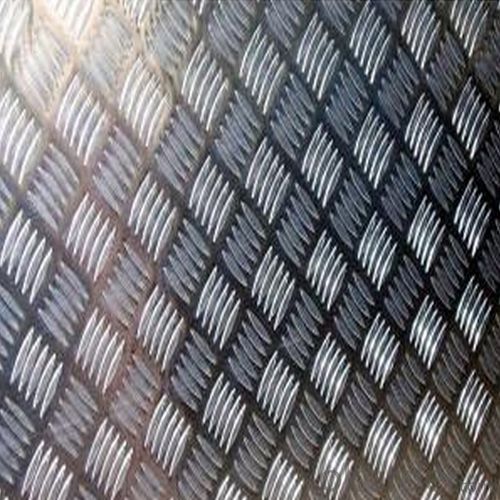
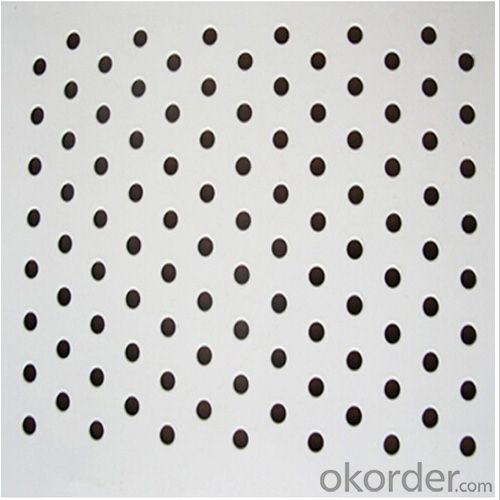
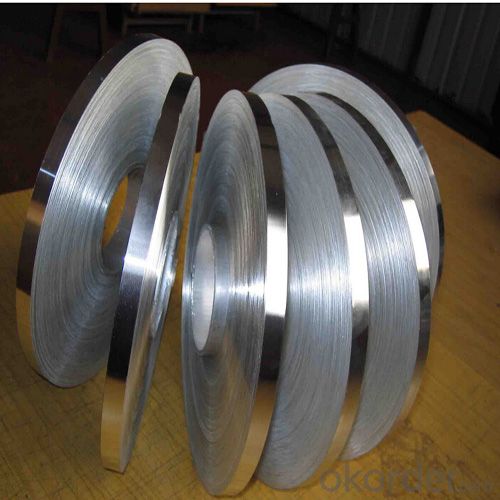
4. Embossed Internal Color Coating Aluminium Plate Specification:
| Alloy | AA1100, 3003, 3004, 3105, 5006, 5052, 8011, etc , etc. |
| Temper | H16, H18, H24, H26, H28 |
| Thickness | From 0.1mm to 1.2mm |
| Width | Standard width:1240mm, 1270MM |
| Special width:1000mm, 1200mm, 1240mm, 1270mm, 1520mm, 1620mm | |
| Diameter | Standard dia:1200mm |
| Interior dia: 150mm,405mm, 500mm, 505mm, 510mm | |
| outer diameter: 1200mm | |
| Weight | 2.5 T/coil,3.0 T/coil |
| Coating thickness | PE:>=16 micron , PVDF:>=25 micron |
| Protective film | As per customer's request |
| Coating paint | PVDF, PE(Polyester), epoxy, polyamide, polyurethane |
| Color | Soid, metallic, high gloss,stone,timber,brush,mirror,sparkling, RAL or by customer requirements. |
| Weight | As per customer's request |
| Surface | Embossed, mill finish, coated |
| Gloss | 10-100% |
| Coating Hardness (pencil resistance) | More than 2h |
| Coating adhesion | 1J |
| Impact Resistance | No peeling or cracking(50 kg/cm) |
| Application | ACP,wall cladding,facades,roofs and canopies,ceilings,signboards,blind window,display platforms,electrical panels,etc |
| Coating Thickness | PE coating:more than 16 micron |
| PVDF coating:more than 25micron |
5.FAQ
Q1.How long have you been in this product?
A1:More than 10 years.
Q2. What's the minium quantity(MOQ)?
A2. 5 Metric tons
Q3. How long is shipping time?
A3. 7 (ready-made products)-25 days(OEM)
Q4. How do you guarantee the quality?
A4. 1. Cooperating and Exchaning experience with sevral quoted aluminum companies
2. Japanese and Swiss production line and skilled works (regular training and testing)
3. more than 10 years production experience.
Q5. Do you have after sale service?
A5. Yes. Any quality problem occurs within one year, pls take photoes,we will be responsible.
- Q: What are the standard sizes of aluminum sheets?
- Aluminum sheet sizes can differ based on the manufacturer and specific needs. Nevertheless, there are several standard sizes commonly found for aluminum sheets. These include 4 feet by 8 feet (1.2 meters by 2.4 meters), 4 feet by 10 feet (1.2 meters by 3 meters), and 5 feet by 10 feet (1.5 meters by 3 meters). These sizes are widely utilized across various industries and are easily accessible in the market. Furthermore, specialized aluminum sheet suppliers can provide custom sizes tailored to meet specific project requirements.
- Q: Do 101 aluminum sheets have any specific sound or vibration damping properties?
- Yes, 101 aluminum sheets have specific sound and vibration damping properties. Aluminum is known for its excellent damping characteristics, meaning it can effectively absorb or dampen vibrations and reduce noise levels. This is due to its high density and stiffness, which allow it to dissipate vibrational energy. Additionally, aluminum sheets can be further enhanced by applying sound-damping coatings or treatments, such as adhesive-backed damping sheets or constrained layer damping materials. These treatments can further improve the sound and vibration damping properties of 101 aluminum sheets, making them a popular choice in various industries where noise reduction and vibration control are important considerations, such as automotive, aerospace, and construction.
- Q: What safety measures should be taken into account when installing aluminum sheets?
- <p>When installing aluminum sheets, it's important to follow safety precautions. Always wear appropriate personal protective equipment, including gloves and safety glasses. Ensure the work area is clear of debris and other hazards. Use the correct tools for cutting and handling aluminum sheets to prevent injuries. Be cautious of sharp edges and corners that can cause cuts. Ensure the aluminum sheets are properly secured to avoid them falling and causing harm. Follow all manufacturer guidelines for installation to ensure the stability and longevity of the aluminum sheets.</p>
- Q: How do you clean and maintain aluminum sheets?
- To clean and maintain aluminum sheets, follow these steps: 1. Start by wiping the surface of the aluminum sheet with a soft cloth or sponge to remove any loose dirt or debris. Avoid using abrasive materials that can scratch the surface. 2. For regular cleaning, mix a mild detergent or dish soap with warm water in a bucket or sink. Dip the cloth or sponge into the soapy water and gently scrub the aluminum sheet, applying light pressure in circular motions. Be sure to clean both sides of the sheet. 3. Rinse the sheet thoroughly with clean water to remove any soap residue. It's important to remove all traces of detergent as it can leave behind a film or residue. 4. For stubborn stains or grime, you can use a non-abrasive cleaner specifically designed for aluminum surfaces. Apply the cleaner to a cloth or sponge and scrub the affected areas. Rinse with clean water afterward. 5. After cleaning, dry the aluminum sheet thoroughly with a clean, soft cloth to prevent water spots or streaks. It's important to dry it completely to avoid any moisture that can lead to corrosion or oxidation. 6. To maintain the aluminum sheet's shine and protect it from future damage, you can apply a thin layer of aluminum polish or wax using a clean cloth. This will create a protective barrier and enhance the sheet's appearance. 7. Regularly inspect the aluminum sheet for any signs of damage, such as scratches or dents. If you notice any issues, take appropriate steps to repair or replace the sheet to prevent further damage. By following these steps, you can effectively clean and maintain aluminum sheets, ensuring their longevity and preserving their appearance.
- Q: Are aluminum sheets suitable for hydraulic applications?
- Yes, aluminum sheets are suitable for hydraulic applications. Aluminum is known for its excellent strength-to-weight ratio, corrosion resistance, and high thermal conductivity, making it a suitable material for hydraulic systems. It is commonly used in the construction of hydraulic tanks, cylinders, and other components due to its durability and ability to withstand high pressure and fluid flow.
- Q: Are aluminum sheets suitable for food processing applications?
- Aluminum sheets are indeed suitable for food processing applications. The reason behind their popularity in the food processing field lies in their outstanding properties, which include corrosion resistance, thermal conductivity, and low reactivity with food substances. These sheets find widespread use in a variety of food processing equipment, such as storage containers, cooking utensils, and packaging materials. Moreover, aluminum sheets are lightweight and easy to clean, while also possessing excellent heat distribution properties. This makes them ideal for applications that necessitate precise temperature control during food processing. Furthermore, the use of aluminum ensures food safety and prevents any potential contamination, as it is a non-toxic material. All in all, aluminum sheets are a dependable and extensively employed material within the food processing industry.
- Q: Can the aluminum sheets be used for manufacturing audio amplifier cases?
- Certainly, audio amplifier cases can be manufactured using aluminum sheets. The utilization of aluminum as casing material in audio equipment is highly favored owing to its remarkable combination of lightweight and resilient characteristics. It offers exceptional heat dispersion, a critical aspect for audio amplifiers that generate heat while in operation. Additionally, aluminum can be effortlessly machined and shaped into diverse forms, facilitating customization and aesthetic considerations in the design of the amplifier case. In conclusion, aluminum sheets are a fitting choice of material for the production of audio amplifier cases.
- Q: i want to build a smelter to recycle aluminum auto parts
- Aluminium is usually recycled in the following basic way[2]: In the case of products like aluminium drink cans, the cans are shredded and ground into small pieces. The small pieces are then melted in a furnace to produce molten aluminium (by the end of this stage the recycled aluminium is indistinguishable from virgin aluminium and so further processing is identical for both). Some minor adjustments to the actual composition of the final product is required to eliminate impurities and to conform the recycled aluminium to the proper amalgam from which different materials are manufactured, including slightly different compositions for can bodies and lids. The molten aluminium is then poured in to moulds to create large ingots. The ingots are then forced through rollers to create sheets of aluminium of whatever thickness is required for the product the metal will be used in. The scrap aluminium is separated into a range of categories i.e. irony aluminium (engine blocks etc), alloy wheels, clean aluminium Depending on the specification of the required ingot casting will depend on the type of scrap used in the start melt. Generally the scrap is charged to a reverbatory furnace (other methods appear to be either less economical and/ or dangerous)and melted down to form a bath. the molten metal is tested using spectroscopy on a sample taken from the melt to determine what refinements are needed to produce the final casts. After the refinements have been added the melt may be tested several times to be able to fine tune the batch to the specific standard Once the correct recipe of metal is available the furnace is tapped and poured into ingot moulds, usually via a casting machine. The melt is then left to cool, stacked and sold on as cast silicon aluminium ingot to various industries for re-use.
- Q: What does aluminum plate "3003-H24" mean?
- (1) Hxx state:H1 * - hot rolling, Zhang Liqiang; H2 * - continuous casting and rolling, Zhang Liqiang, part of the toughening; H3 * - after stress treatment, stable performance; H4 * - after paint or coating; H x 2 - 25% x 4 - H hardness; hardness 50% processing; H * 6 - 75% hardness; H * 8 - 90 more than the hardness.(2) Hxxx state:H111: suitable for the final annealing, but also a proper amount of work hardening, but the degree of hardening is not as good as the H11 state of the product.H112: for hot forming products, the mechanical properties of the condition are specified.H116: made for magnesium content more than 4% 5 * * * alloy products. These products have specified mechanical properties and anti stripping corrosion resistance requirements.
- Q: What are the different types of alloys used in aluminum sheets?
- Aluminum sheets utilize a variety of alloys, each possessing distinct properties and advantages. The following are some commonly employed alloys: 1. The 3003 alloy offers exceptional formability, corrosion resistance, and weldability, making it suitable for general-purpose use. It finds applications in cooking utensils, signage, and chemical equipment. 2. Known for its high strength and good corrosion resistance, the 5052 alloy is frequently utilized in marine and automotive fields. It is also employed in sheet metal fabrication and structural components. 3. The 6061 alloy is highly versatile and finds application in several sectors such as aerospace, automotive, and structural components. It provides excellent strength, machinability, and weldability. 4. Primarily used in aerospace and high-strength applications, the 7075 alloy boasts an exceptional strength-to-weight ratio. It is commonly employed in aircraft fittings, gears, and bike frames. 5. The 2024 alloy, popular in aerospace applications, exhibits a high strength-to-weight ratio and excellent fatigue resistance. It is commonly used for aircraft structures, bolts, and rivets. 6. The 5083 alloy, specifically designed for marine applications, showcases outstanding corrosion resistance and high strength. It is frequently utilized for boat hulls and structural components. These are merely a few instances of the diverse alloys employed in aluminum sheets. Each alloy possesses a unique combination of properties that enable it to excel in specific applications.
Send your message to us
Decorative Aluminum Coated Mylar Plastic Sheets for Aluminium Roofing Coils
- Loading Port:
- Shanghai
- Payment Terms:
- TT OR LC
- Min Order Qty:
- 5 m.t.
- Supply Capability:
- 10000 m.t./month
OKorder Service Pledge
OKorder Financial Service
Similar products
Hot products
Hot Searches
Related keywords
